Banasura Hill Resort
| Banasura Hill Resort | |
|---|---|
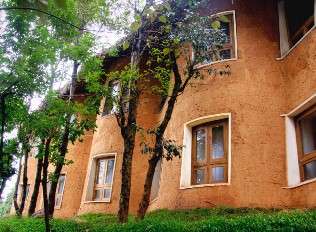 | |
| General information | |
| Type | Rammed Earth Architecture |
| Architectural style | Indegineous Sustainable architecture |
| Location | Wayanad, Kerala |
| Country | India |
| Coordinates | 11°42′49″N 75°55′23″E / 11.71361°N 75.92306°E |
| Elevation | 976m (3202ft) |
| Construction started | July 2008 |
| Completed | January 2010 |
| Design and construction | |
| Architect | Eugene Pandala |
| Website | |
 | |
Banasura Hill Resort is a nature resort in Wayanad District of North Kerala; located 37 km away from Kalpetta, the district headquarters. It stands at an altitude of 3200 feet above sea level on a sprawling 35 acre plot amidst the rugged mountains of the Western Ghats declared as one of the traditionally preserved sites in the world by UNESCO.[1]
Etymology
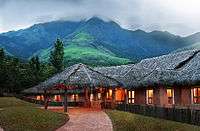
The resort is so named because it is located at the foot of the Banasura Hill which is the second highest mountain in Wayanad that often attracts climbers to attempt to reach the summit.[2] Besides this, the picturesque Banasura Sagar Dam, which lies just 18 km from the resort and shares its architectural antecedents also had an influence in naming the resort.
Unique Architecture
The resort's architectural design follows a construction based on rammed earth. The various living structures within the resort complex is constructed using mud excavated from the very site where it stands on.
The main building has an area of nearly 20,000 square foot spread over two floors, and is made entirely out of mud, with a roof of bamboo and coconut palm fronds.[3]
The Idea Behind Banasura
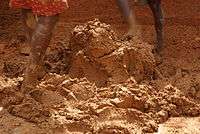

Considerable amount of research went in before deciding on the type of architecture to be used in construction. “Earth” architecture was chosen because it would cause the least amount of ecological damage while blending harmoniously with the micro environment around the site. “Earth” (mud) that is used for construction can be recycled indefinitely or left to disintegrate without causing any environmental degradation.
Research also threw up striking examples of large earthen structures that had withstood the test of time and survived for centuries. The Great Mosque of Djenné in Mali built in 1907, the Citadel of Rayen in Iran built during the Parthian rule (248 BC–224 AD); and the ancient city of Shibam in Yemen built in the 2nd century A.D are some such structures.
Inspired by these examples, rammed earth (or pise) was chosen as the architecture to be adopted for constructing the resort. This construction technique was developed in ancient China around 2,000 B.C, and used predominantly to build protective walls around small settlements. The Great Wall of China is one of the best examples where rammed earth was used.[4] Closer to the resort, the Banasura Sagar Dam, which is India’s largest earthen dam, and the second largest in Asia, also prompted adoption of this eco-friendly design.
Size & Challenges
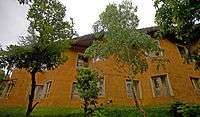

Fairly large single-storied earthen structures are common in different parts of the world, but building a two-storied structure of such enormous proportions as that of the main building at the resort, was quite a challenge. Since the building was designed without any concrete pillars, extra attention had to be paid to load bearing and load balancing aspects to ensure stability.
Climatic conditions are a major concern while building earthen structures. Typically, earthen buildings are found in areas where the climate is dry and arid. Wayanad, where Banasura Hill Resort is located, has a tropical wet climate – also known as a tropical monsoon climate – with an annual average rainfall of well over 2,300mm. While the heavy monsoon rains are responsible for the tropical rain forests and the rich bio-diversity found in these parts, building a rammed colossal earth structure under such climatic conditions is a challenge. Despite this, construction of the main building was completed within 18 months.[5]
Expertise of Local Tribesmen
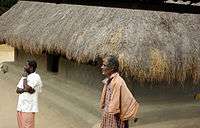
Close to the resort there are four hamlets belonging to the indigenous Kurichiya tribe.[6] They live mostly in mud huts with thatched roofs. Their expertise in building with mud was used extensively in the construction of the resort by blending traditional building techniques with modern design concepts.
Indigenous Sustainable Architecture
Banasura Hill Resort makes optimal use of environmental resources. As it is built using mud; the structures of the resort gel seamlessly with the natural surroundings. The design itself contributes actively to energy conservation. The thick earthen walls provide thermal insulation, keeping the interiors cool during the day and warm and cozy during the night, obviating the need for air-conditioning. The ambience that the interiors of the earthen structures provide is one of cool comfort.
A Slice of History
In the wake of Tipu Sultan's defeat in the Battle of Seringapatam, Wayanad which was then ruled by the Rajas of the Kottayam royal family came under the rule of the British. The British imposed exorbitant tax on agricultural products like pepper, causing inexorable hardships to the people of the region. Kerala Varma Pazhassi Raja, the then ruler of Wayanad, defied the British and refused to collect the taxes. This led to open confrontation between the British and the Raja, who was eventually forced to flee from his palace, and seek refuge in the jungles of Wayanad with his wife and some trusted supporters.
During his sojourn in the jungles, the Raja came across several tribal settlements, one of which belonged to the Kurichiyas, a tribe with a strong martial tradition. The Kurichiyas were exceptionally good marksmen who hunted game using bows and arrows. The area around Banasura Hill and the resort with its thick forests and rich wildlife formed an ideal hunting ground for the Kurichiyas. The numerous natural caves in the area close to perennial water courses, made it the ideal hide out for the Raja as well.[7]
The Kurichiyas who had intimate knowledge of the topography offered their help. With their support, the Raja engaged the British in a long drawn guerrilla war which eventually led to the Raja's death and the disbanding of the tribal army. One of the Kurichiya tribal hamlets is still in existence at the foot of the Banasura Hill about 5 km from the resort. They still recount stories of how their forefathers helped the Raja in his fight against the British.
Environmental Conservation
Being an Eco Resort, Banasura Hill Resort has taken measures to conserve the ecological balance of the place and preserve its natural heritage and biodiversity. For example, Guadua bamboo saplings have been planted in and around the resort to create a bio-fencing. Its environmental benefits include regulating water levels, absorbing huge amounts of carbon dioxide from the atmosphere, producing oxygen, preventing soil erosion and conserving bio diversity. Also planted in thousands are seedlings of the highly aromatic Vetiver grass whose cluster roots run vertically like a mesh to a depth of almost 5m, effectively preventing soil erosion and arresting water run-off.[8] These measures help to conserve the ecological balance of the place and preserve its natural heritage and biodiversity.
One of India's Best Eco-resorts
The resort stands in the middle of a sprawling Tea estate. Large areas have also been devoted to the cultivation of pepper, coffee and arecanut. Tall Rosewood and Eucalyptus trees are a common sight throughout the resort. All these coupled with the scenic beauty and the pristine environment contribute to make Banasura Hill Resort one of India's best eco-resorts.[9]
References
- ↑ "UNESCO world heritage sites list". UNESCO Official website. Archived from the original on July 30, 2012. Retrieved 13 July 2012.
- ↑ "Deccan Chronicle - Reference of Banasura Hill". Deccan Chronicle Website. Archived from the original on July 30, 2012. Retrieved 13 July 2012.
- ↑ "Main building made of mud with bamboo roof and coconut palm fronds". The Hindu Website. Archived from the original on July 30, 2012. Retrieved 13 July 2012.
- ↑ "Construction material of China Great Wall". Travel China Guide. Archived from the original on July 30, 2012. Retrieved 13 July 2012.
- ↑ "Challenges of Rammed Earth construction". How Stuff Works Official Website. Archived from the original on July 30, 2012. Retrieved 13 July 2012.
- ↑ "Kurichiyas presence in Wayanad". Wayanad Website. Archived from the original on July 30, 2012. Retrieved 13 July 2012.
- ↑ "Kurichiyas presence in and around Banasura Hill". Gokerala Website. Archived from the original on July 30, 2012. Retrieved 30 July 2012.
- ↑ "Vetiver Grass prevents soil erosion". Utilization of Vetiver grass by The Chaipattana foundation. Archived from the original on July 30, 2012. Retrieved 17 July 2012.
- ↑ "India's best eco resort". MSN Green Website. Archived from the original on 30 July 2012. Retrieved 20 July 2012.